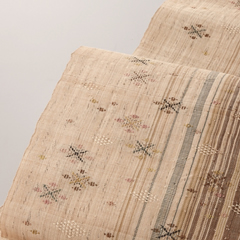KIJOKA no Bashofu (Banana Fiber Textiles)

Banana fiber cloth was already being made around the 13th century, but it became popular much later. In the old days, banana trees were planted in gardens and fields, and the family women wove it into fabric for home use. Silk and cotton became more readily available during the 19th century but people still enjoyed wearing banana fiber cloth. Kijoka no Bashofu, which carries on these traditions, was designated as a cultural property by Okinawa Prefecture in 1972. Two years later in 1974 it was made an important intangible cultural property country of Japan.
Woven from fibers taken from the banana tree, banana fiber cloth is highly representative of Okinawan weaving. It was very popular for making a piece of summer-weight formal dress called kamishimo in the Edo era (1600-1868). Light and comfortable, it is still popular with people today for kimonos in the height of summer. But kimonos are not its only use—the engaging fabric is made into obi sashes, fine cushion covers, neckties, bags, table centers and split entryway curtains (noren).
Feature
Bashofu is a traditional Okinawan clothing made from fibers stripped from the itobasho plant (musa liukiuensis). It was popular for summer clothing during the Edo ra. Light and smooth to the touch, it is still popular for summertime kimonos today.
How to make
Stems of three year-old itobasho plants are split into four parts and boiled to remove impurities before the fibers are removed. The fibers are tied with a weaver’s knot to make them longer as each fiber is less than 1m long. The threads are twisted and ikat dyed with natural dyes. After being hand woven, they are refined with wood ash, washed with rice vinegar and finished by being hand-stretched. It takes a long time from the cultivation of and itobasho plant to completion of the fabric.

